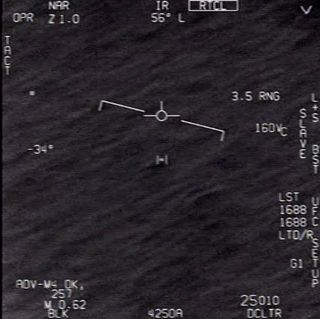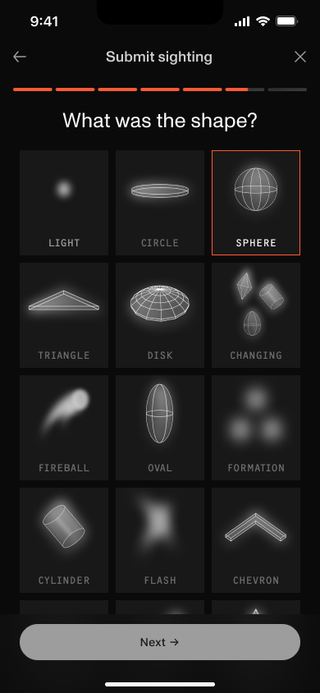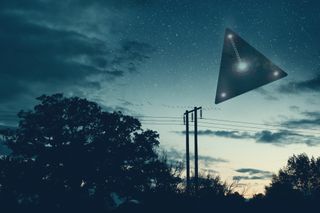
Unidentified aerial annoyance: Full disclosure or dubious UFO nonsense?
Whatever is at play here, organizations are taking close encounters with weirdness seriously.

The coming year will surely see a persistence of debate, discussion and disbelief regarding anonymous airborne occurrences.
Today they are branded as Unidentified Anomalous Phenomenon (UAP). But perhaps UAP is an off-shoot of "flying saucers" from afar, and once identified, will satisfy those hungry for a governmental confession that over the decades Unidentified Flying Objects (UFOs) have assaulted our atmospheric, as well as mental airspace.
Whatever is at play here, organizations are taking close encounters with weirdness seriously.
What confidently looms ahead is an entire year of UAP and UFO banter. Could 2023 become the year of the great reveal, the "truth" that Earth is on the receiving end of full-body contact with other star folk?
Conversely, will it be one more calendar year that adds up to a nothing burger and confusing brouhaha?
Related: Pentagon releases its long-awaited 2022 UFO report
Truth revealed?
Soon to hit the airwaves is the multi-episode docuseries, "UFOs: Investigating the Unknown." It premiers on the National Geographic TV channel on Feb. 13.
Get the Space.com Newsletter
Breaking space news, the latest updates on rocket launches, skywatching events and more!
According to National Geographic, it has been over 50 years that the U.S. government has snubbed the discussion of UFOs, "but now, Navy pilots tell of seeing mysterious objects tracking their fighter jets — vehicles unlike anything they've ever seen before; top-secret Naval videos are leaked that captivate the world."
The topic has garnered recent U.S. military and congressional investigation. "At long last, it looks like the truth about UFOs may finally be revealed," National Geographic suggests. Indeed, NASA, and several private organizations are flexing their research muscle into appraising the UAP state of affairs.
More to the point is the ongoing work of the Office of the Director of National Intelligence (ODNI) and the newly established All-domain Anomaly Resolution Office (AARO).
The 2022 Annual Report on Unidentified Aerial Phenomena is available at ODNI's website.
All this sky-high investigation is meant to get to the bottom of what's up in UFO and UAP sightings.
Exciting data
In the meantime, the upcoming "investigative docuseries" at National Geographic is the product of Leslie Kean, an independent investigative reporter and author of "UFOs: Generals, Pilots and Government Officials Go on the Record" (Crown Publishing Group, 2010).
Kean says that another ODNI report on UAP is due later this year, to follow the one that was just released on Jan. 12.
"I hope the next one will provide us with more information and case details than the latest one, as I'm sure many others do," Kean told Space.com. A lot could happen this year to make that possible, she feels.
For one, the Galileo Project, led by astrophysicist Avi Loeb at Harvard University, could come up with some exciting data, says Kean. "The Galileo Project is engaged in a systematic scientific search for evidence of extraterrestrial technological artifacts. It does not work with classified information or unreliable past data. All discoveries will immediately be made public."

Consolidation of data
Kean underscores the work of the AARO that reports to officials within the U.S. Defense Department and the intelligence community.
"This agency's job is to get the cooperation of all the relevant military services and intelligence agencies. This collaboration allows for the consolidation of data on UAP from a wide range of locations and official data bases."
Congress will be monitoring this process, Kean adds. "It's my understanding that the consolidation of data is a lengthy process and that this has been the major focus of AARO so far, along with building and staffing the operation."
Gold standard
Joining in on the study of UAP is New York-based Enigma Labs, offering a global platform for sightings, explaining that it's the world's first UAP analytics and community platform. "Come search with us," they say, "we're building the gold standard for collecting sighting data and empowering future observers."
By downloading the Enigma Labs mobile app and perusing their website, users can explore a trove of historical and fresh UAP sightings, both from citizens and documented military cases.
"The goal of the app is to continue reducing the stigma around reporting a potential UAP sighting and help drive a fact-based public conversation on the topic," explains Enigma. "Enigma is the first tech-enabled platform to standardize sightings reports and make them queryable and accessible to the public."
Alex Smith, founder of Enigma Labs, notes in a statement: "Our platform already has some of the top experts in the field, including aviators, scientists, former military personnel and more, and we are ready to open up our database to a larger swathe of the general population."

Enticing scientific thinking
Like-minded is the Scientific Coalition for UAP Studies (SCU), a group comprised of over 200 members, including university professors, high-tech and defense industry experts, along with scientists, intelligence specialists and former members of space research organizations.
New federal government interest should be commended, the Coalition says in a statement, "for reducing the stigma in the study of a subject that has long been neglected."
The AARO has come to the same conclusion that the Coalition's UAP research community has found, that a percentage of UAP "appear to have demonstrated unusual flight characteristics or performance capabilities and require further analysis."
Nonetheless, the Coalition calls for more information from the AARO regarding UAP characteristics "in order to entice the broader scientific community to engage in the UAP subject."

Citizen science
Taking note of the fast-paced evolution of private-sector initiatives to scope out UAP is Greg Eghigian, a professor of history and bioethics at Penn State University and a well-known UAP/UFO researcher.
"This kind of citizen science work has been going on in 'ufology' since at least the 1960s, and I suppose you could say it's the very definition of ufology," Eghigian told Space.com. However, he thinks it is fair to say that the equipment today is likely superior to what folks had available in those past days.
But as U.S. government officialdom and private-sector enterprises step forward, armed with ambition and equipment, will amassed data on unknown aerial phenomenon be shared and coordinated?
"I think there is likely to be coordination only within the different silos that exist," Eghigian adds, for example across federal government agencies. "Cohesiveness in this area has always been a challenge."
Eghigian supposes that one might make the argument that different initiatives run by different groups with different methods may actually serve the problem better than a one-size fits all approach. "In the end, however, I'm still not sure where all this is heading and what it all adds up to," he says.
Eroding stigma
In viewing the UAP matter broadly — if you see it as more than simply addressing the question "what are they?" — Eghigian feels real progress is being made.
"Yes, the stigma surrounding the phenomenon is beginning to erode, but it's still there. That said, given the hype and speculation surrounding UAP, dubiousness is not always unwarranted. It's clear that not everyone at the table is necessarily qualified to speak substantively about the issues at hand," he says.
However, in 2023 alone, Eghigian adds, there is going to be at least three academic conferences on the topic, each one generally focusing on different facets, with input from the natural sciences, social sciences, and humanities.
"I think this kind of interdisciplinary approach to studying and discussing the matter, always grounded in careful, empirical research, is welcome and should be encouraged," Eghigian concludes.
Follow us @Spacedotcom, or on Facebook and Instagram.
Join our Space Forums to keep talking space on the latest missions, night sky and more! And if you have a news tip, correction or comment, let us know at: community@space.com.

Leonard David is an award-winning space journalist who has been reporting on space activities for more than 50 years. Currently writing as Space.com's Space Insider Columnist among his other projects, Leonard has authored numerous books on space exploration, Mars missions and more, with his latest being "Moon Rush: The New Space Race" published in 2019 by National Geographic. He also wrote "Mars: Our Future on the Red Planet" released in 2016 by National Geographic. Leonard has served as a correspondent for SpaceNews, Scientific American and Aerospace America for the AIAA. He was received many awards, including the first Ordway Award for Sustained Excellence in Spaceflight History in 2015 at the AAS Wernher von Braun Memorial Symposium. You can find out Leonard's latest project at his website and on Twitter.
-
Manix The stigma with this subjected has always been unwarranted. Unlike many subjects considered "paranormal" this subject is clearly grounded in science. IF indeed these UAP are otherworldly, again still grounded in science. What I feel drove the stigma back in the day, was religion (specifically Christianity), as followers was taught God made them and them alone. Today (even within religion) people are more readily accepting we are not alone in the Universe. As much as many reporting on the subject would have the average or pedestrian reader on the subject believe, this is a new phenomena and yet it is not. Sure some (even many today) sighting can be chalked down to new secret/ classified projects, but that does not account for cases hundred (even thousands) of years ago; our scientists and engineers might be smart, but unless they've invented a time machine (which would be equally if not more exciting than finding out we was visited by ET's or interdimensional alopers), I have a hard time believing UAPs (the more curious cases) are down to our governments. I also feel human arrogance is something that also prevents us from accepting this. We like to think we're the be all and end all of everything and the smartest thing in the Universe. IF ET's have made it here and that info is disclosed, then we would suddenly become less important in the grand scheme of things and to many this is unacceptable, true or not.Reply -
mig75 Disclosure already happened in the UK : they said ufos exist and surely are buoyant plasmas linked 60% of times with meteors, probably linked with ball lightning too. See Project Condign.Reply
The Pentagon recognized that paranormal phenomena and cryptids appeared commonly during UAP sightings too.
There is an explanation proposed for all this called "electroballs".
They are bilayer bicharge balls of ionized air or plasma formed by static electricity. They are explained here: https://electroballpage.wordpress.com/ -
billslugg Whoever is the first to prove the existence of ET will become the most famous person in the world and will be showered with money and attention like no other. This is why we are skeptical of first person accounts.Reply
Deepfake photos and movies can fool anyone at any time about any thing. This is why we are skeptical of images.
Given a physical object from an ET the proof is trivial. Any large university can subject it to isotopic analysis and prove the case.
Foget about stories, forget about pictures, bring me a matchbook cover or a fingernail clipping.
I don't care to hear another impassioned opinion or sincere belief, a million times nothing is still nothing. -
murgatroyd These strawman arguments are getting really threadbare ... No, most people who see no reason to take seriously the claim that there is evidence of spacecraft from elsewhere in the universe zipping around in our atmosphere, do NOT maintain that "we're the be all and end all of everything and the smartest thing in the Universe".Reply
You can put the odds of another technological civilization in the universe as high as you wish, a million to one, a billion to one. This has no bearing whatsoever on whether any of the claims stand up to scrutiny. So far, not one of them has. -
billslugg That's right, murgatroyd, if one has no case the best option is to attack the motives of the critics.Reply -
MiddlePillar I heard Prof Kaku make a good point. The reports that are coming from pilots, astronauts, hard data collections, & other professional observers change the face of the conversation. The new reporting inclusion in the latest defense budget will allow a process for previous military personnel to get out from under their military non-disclosures and speak freely.Reply -
billslugg The value of professional pilot and military pilot accounts is to stimulate further investigation. No amount of professional accounts can prove the case for ET. Only a physical piece of one can do that.Reply -
Dave Yes the stigma is still there. Looking forward to the series by National Geographic.Reply
There will always be 'those people" who say, 'intelligent lifeforms in our galaxy cannot possibly exist.' I invite all of those people, to look in the mirror as they say it.
What is the joke again? "Take me to your leader." The funny thing is, we are the joke. The human race has no leader. It just goes to show how socially backward we truly are.
Simply put. another species is observing us and they do not wish to have their presence known period. They have the technology to do so.
And what is it, that they observe?
What all humans seem to be really good at truly, is making war amongst ourselves. If you are an advanced race, you would not contact a species as primitive as we are. From their point of view, we just kill one another. We are just savages. Do you think they would see us as friendly?
Perhaps one day as a race we will be as one. Only time will tell. -
murgatroyd Reply
*sigh* see above (strawman argument).Dave said:There will always be 'those people" who say, 'intelligent lifeforms in our galaxy cannot possibly exist.'
Your speculative musings about the presence here of extraterrestrials may seem plausible to you. They do not to me. Now what? -
MiddlePillar Reply
Ronald Reagan basically said the same thing in a speech. Apparently he was a proponent of disclosure but followed the advice of his military. He in 1987 at the UN he said...Dave said:Yes the stigma is still there. Looking forward to the series by National Geographic.
There will always be 'those people" who say, 'intelligent lifeforms in our galaxy cannot possibly exist.' I invite all of those people, to look in the mirror as they say it.
What is the joke again? "Take me to your leader." The funny thing is, we are the joke. The human race has no leader. It just goes to show how socially backward we truly are.
Simply put. another species is observing us and they do not wish to have their presence known period. They have the technology to do so.
And what is it, that they observe?
What all humans seem to be really good at truly, is making war amongst ourselves. If you are an advanced race, you would not contact a species as primitive as we are. From their point of view, we just kill one another. We are just savages. Do you think they would see us as friendly?
Perhaps one day as a race we will be as one. Only time will tell.
“Perhaps we need some outside universal threat to make us recognize this common bond. I occasionally think how quickly our differences worldwide would vanish if we were facing an alien threat from outside this world.”
